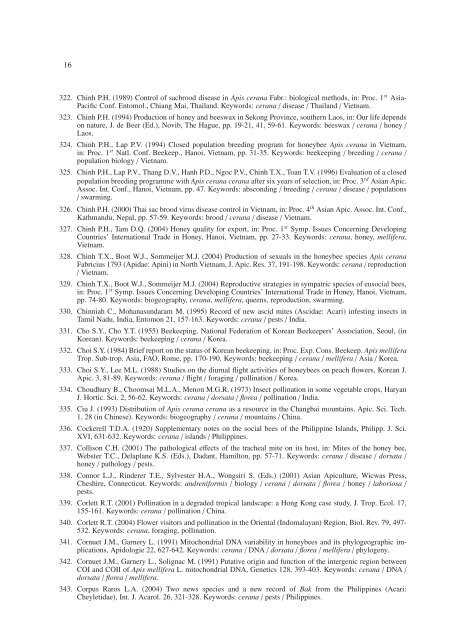Bibliography of Apis cerana Fabricius - Apidologie
Bibliography of Apis cerana Fabricius - Apidologie
Bibliography of Apis cerana Fabricius - Apidologie
You also want an ePaper? Increase the reach of your titles
YUMPU automatically turns print PDFs into web optimized ePapers that Google loves.
16<br />
322. Chinh P.H. (1989) Control <strong>of</strong> sacbrood disease in <strong>Apis</strong> <strong>cerana</strong> Fabr.: biological methods, in: Proc. 1st Asia-<br />
Pacific Conf. Entomol., Chiang Mai, Thailand. Keywords: <strong>cerana</strong> / disease / Thailand / Vietnam.<br />
323. Chinh P.H. (1994) Production <strong>of</strong> honey and beeswax in Sekong Province, southern Laos, in: Our life depends<br />
on nature, J. de Beer (Ed.), Novib, The Hague, pp. 19-21, 41, 59-61. Keywords: beeswax / <strong>cerana</strong> / honey /<br />
Laos.<br />
324. Chinh P.H., Lap P.V. (1994) Closed population breeding program for honeybee <strong>Apis</strong> <strong>cerana</strong> in Vietnam,<br />
in: Proc. 1st Natl. Conf. Beekeep., Hanoi, Vietnam, pp. 31-35. Keywords: beekeeping / breeding / <strong>cerana</strong> /<br />
population biology / Vietnam.<br />
325. Chinh P.H., Lap P.V., Thang D.V., Hanh P.D., Ngoc P.V., Chinh T.X., Toan T.V. (1996) Evaluation <strong>of</strong> a closed<br />
population breeding programme with <strong>Apis</strong> <strong>cerana</strong> <strong>cerana</strong> after six years <strong>of</strong> selection, in: Proc. 3rd Asian Apic.<br />
Assoc. Int. Conf., Hanoi, Vietnam, pp. 47. Keywords: absconding / breeding / <strong>cerana</strong> / disease / populations<br />
/ swarming.<br />
326. Chinh P.H. (2000) Thai sac brood virus disease control in Vietnam, in: Proc. 4th Asian Apic. Assoc. Int. Conf.,<br />
Kathmandu, Nepal, pp. 57-59. Keywords: brood / <strong>cerana</strong> / disease / Vietnam.<br />
327. Chinh P.H., Tam D.Q. (2004) Honey quality for export, in: Proc. 1st Symp. Issues Concerning Developing<br />
Countries’ International Trade in Honey, Hanoi, Vietnam, pp. 27-33. Keywords: <strong>cerana</strong>, honey, mellifera,<br />
Vietnam.<br />
328. Chinh T.X., Boot W.J., Sommeijer M.J. (2004) Production <strong>of</strong> sexuals in the honeybee species <strong>Apis</strong> <strong>cerana</strong><br />
<strong>Fabricius</strong> 1793 (Apidae: Apini) in North Vietnam, J. Apic. Res. 37, 191-198. Keywords: <strong>cerana</strong> / reproduction<br />
/ Vietnam.<br />
329. Chinh T.X., Boot W.J., Sommeijer M.J. (2004) Reproductive strategies in sympatric species <strong>of</strong> eusocial bees,<br />
in: Proc. 1st Symp. Issues Concerning Developing Countries’ International Trade in Honey, Hanoi, Vietnam,<br />
pp. 74-80. Keywords: biogeography, <strong>cerana</strong>, mellifera, queens, reproduction, swarming.<br />
330. Chinniah C., Mohanasundaram M. (1995) Record <strong>of</strong> new ascid mites (Ascidae: Acari) infesting insects in<br />
Tamil Nadu, India, Entomon 21, 157-163. Keywords: <strong>cerana</strong> / pests / India.<br />
331. Cho S.Y., Cho Y.T. (1955) Beekeeping, National Federation <strong>of</strong> Korean Beekeepers’ Association, Seoul, (in<br />
Korean). Keywords: beekeeping / <strong>cerana</strong> / Korea.<br />
332. Choi S.Y. (1984) Brief report on the status <strong>of</strong> Korean beekeeping, in: Proc. Exp. Cons. Beekeep. <strong>Apis</strong> mellifera<br />
Trop. Sub-trop. Asia, FAO, Rome, pp. 170-190. Keywords: beekeeping / <strong>cerana</strong> / mellifera / Asia / Korea.<br />
333. Choi S.Y., Lee M.L. (1988) Studies on the diurnal flight activities <strong>of</strong> honeybees on peach flowers, Korean J.<br />
Apic. 3, 81-89. Keywords: <strong>cerana</strong> / flight / foraging / pollination / Korea.<br />
334. Choudhury B., Choomsai M.L.A., Menon M.G.R. (1973) Insect pollination in some vegetable crops, Haryan<br />
J. Hortic. Sci. 2, 56-62. Keywords: <strong>cerana</strong> / dorsata / florea / pollination / India.<br />
335. Ciu J. (1993) Distribution <strong>of</strong> <strong>Apis</strong> <strong>cerana</strong> <strong>cerana</strong> as a resource in the Changbai mountains, Apic. Sci. Tech.<br />
1, 28 (in Chinese). Keywords: biogeography / <strong>cerana</strong> / mountains / China.<br />
336. Cockerell T.D.A. (1920) Supplementary notes on the social bees <strong>of</strong> the Philippine Islands, Philipp. J. Sci.<br />
XVI, 631-632. Keywords: <strong>cerana</strong> / islands / Philippines.<br />
337. Collison C.H. (2001) The pathological effects <strong>of</strong> the tracheal mite on its host, in: Mites <strong>of</strong> the honey bee,<br />
Webster T.C., Delaplane K.S. (Eds.), Dadant, Hamilton, pp. 57-71. Keywords: <strong>cerana</strong> / disease / dorsata /<br />
honey / pathology / pests.<br />
338. Connor L.J., Rinderer T.E., Sylvester H.A., Wongsiri S. (Eds.) (2001) Asian Apiculture, Wicwas Press,<br />
Cheshire, Connecticut. Keywords: andreniformis / biology / <strong>cerana</strong> / dorsata / florea / honey / laboriosa /<br />
pests.<br />
339. Corlett R.T. (2001) Pollination in a degraded tropical landscape: a Hong Kong case study, J. Trop. Ecol. 17,<br />
155-161. Keywords: <strong>cerana</strong> / pollination / China.<br />
340. Corlett R.T. (2004) Flower visitors and pollination in the Oriental (Indomalayan) Region, Biol. Rev. 79, 497-<br />
532. Keywords: <strong>cerana</strong>, foraging, pollination.<br />
341. Cornuet J.M., Garnery L. (1991) Mitochondrial DNA variability in honeybees and its phylogeographic implications,<br />
<strong>Apidologie</strong> 22, 627-642. Keywords: <strong>cerana</strong> / DNA / dorsata / florea / mellifera / phylogeny.<br />
342. Cornuet J.M., Garnery L., Solignac M. (1991) Putative origin and function <strong>of</strong> the intergenic region between<br />
COI and COII <strong>of</strong> <strong>Apis</strong> mellifera L. mitochondrial DNA, Genetics 128, 393-403. Keywords: <strong>cerana</strong> / DNA /<br />
dorsata / florea / mellifera.<br />
343. Corpus Raros L.A. (2004) Two news species and a new record <strong>of</strong> Bak from the Philippines (Acari:<br />
Cheyletidae), Int. J. Acarol. 26, 321-328. Keywords: <strong>cerana</strong> / pests / Philippines.




